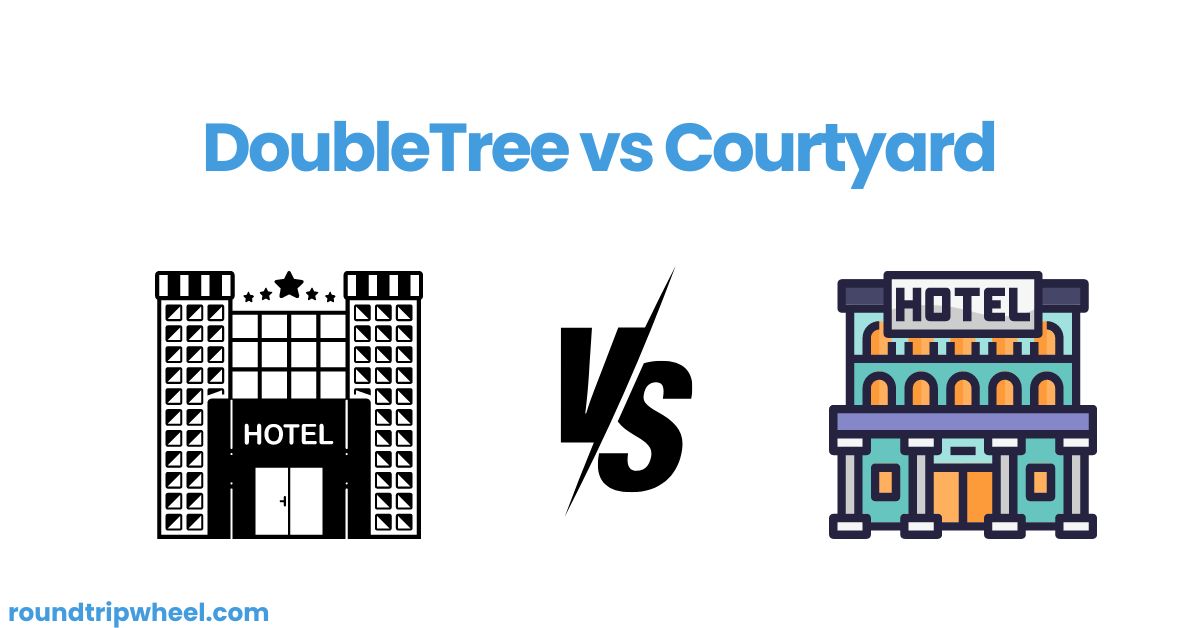DoubleTree vs Courtyard: Choosing the Right Hotel for Your Stay

When planning a trip, one of the most important decisions is where to stay. Two popular mid-range hotel chains that often come up in comparisons are DoubleTree by Hilton and Courtyard by Marriott. While both offer comfortable accommodations for business and leisure travelers, there are some key differences to consider when deciding between the two. This article will provide an in-depth comparison of DoubleTree and Courtyard hotels to help you determine which is the best fit for your next stay.
Brand Overview
DoubleTree by Hilton:
DoubleTree is an upscale hotel chain owned by Hilton Worldwide. The brand is known for its signature warm chocolate chip cookies given to guests at check-in. DoubleTree hotels aim to provide a more upscale full-service experience compared to limited-service brands.
Courtyard by Marriott:
Courtyard is a select-service hotel chain owned by Marriott International. It was one of the first hotel brands specifically designed for business travelers. Courtyard hotels offer modern amenities and spaces geared towards both productivity and relaxation.
Room Types and Amenities
DoubleTree:
– Typically offers a mix of standard rooms and suites
– Many locations have two-room suites with separate living areas
– Rooms usually include a mini-fridge and microwave
– Bathrooms often have full-size tubs
– In-room coffee makers and tea service
– Signature Sweet Dreams bedding
Courtyard:
– Mostly standard rooms with some locations offering suites
– Rooms designed with separate areas for working, sleeping, and relaxing
– Mini-fridges in most rooms
– Bathrooms usually have shower/tub combos
– In-room coffee makers
– Plush bedding and linens
Both chains offer the essential amenities travelers expect like free WiFi, flat-screen TVs, work desks, and premium bath products. DoubleTree tends to have slightly more spacious rooms on average. The two-room suites at many DoubleTree properties can be great for families or extended stays. Courtyard’s room layouts are efficient and functional, with defined zones for different activities.
Dining Options
DoubleTree:
– Full-service restaurants at most locations
– Room service available at many properties
– On-site bars/lounges common
– Complimentary breakfast not typically included
Courtyard:
– The Bistro restaurant concept at most locations serving breakfast and dinner
– Starbucks coffee often available
– Limited room service at some properties
– Complimentary breakfast not included
DoubleTree generally offers more extensive on-site dining with full restaurants and bars. This can be convenient for travelers who want to dine at the hotel. Courtyard’s Bistro provides quick, casual options for breakfast and dinner, but may have more limited hours. Neither chain includes free breakfast with standard rates, though packages are sometimes available.
Fitness and Recreation
DoubleTree:
– Fitness centers with cardio equipment and free weights
– Many properties have swimming pools, some indoor
– Some locations offer spa services
Courtyard:
– 24/7 fitness centers
– Swimming pools at many locations
– Sport courts at some properties
Both chains reliably offer fitness centers and pools at most locations. DoubleTree may have slightly more extensive recreation options at some properties, potentially including things like tennis courts or putting greens. Courtyard fitness centers tend to be well-equipped and open 24 hours for guest convenience.
Business and Event Facilities
DoubleTree:
– Meeting rooms and ballrooms for events
– Business centers with computers and printers
– A/V equipment available
Courtyard:
– Small meeting rooms at most properties
– Communal workspaces in lobbies
– Business centers with computers and printers
DoubleTree hotels are often larger and better equipped to host meetings and events. Many have extensive conference facilities and dedicated event staff. Courtyard properties typically have more limited meeting space, but the brand caters well to individual business travelers with practical amenities and workspaces.
Loyalty Programs
DoubleTree: Hilton Honors
– Points can be earned and redeemed across Hilton’s portfolio of brands
– Member benefits like late checkout and free WiFi
– Status tiers with increasing perks
Courtyard: Marriott Bonvoy
– Unified program across Marriott’s 30+ brands
– Points earning and redemption
– Elite status tiers with benefits like room upgrades
Both loyalty programs offer good value for frequent travelers. Marriott Bonvoy has a slight edge in terms of the number of properties where points can be earned and redeemed. However, Hilton Honors points are generally easier to earn quickly. Consider which program aligns best with your travel patterns and preferred brands.
Pricing and Value
Pricing can vary significantly based on location, seasonality, and demand. In general:
DoubleTree:
– Often priced slightly higher than Courtyard
– More likely to have resort fees at some locations
– May offer better value for longer stays in suites
Courtyard:
– Usually priced in the mid-range for business hotels
– Fewer additional fees
– Good value for short business trips
While individual rates will vary, DoubleTree tends to position itself as a more upscale option with pricing to match. Courtyard aims to provide good value for business travelers with efficient service and practical amenities. Always compare specific rates for your dates and destination to find the best deal.
Location and Availability
DoubleTree:
– Over 600 properties worldwide
– Mix of urban, suburban, and resort locations
– Strong presence in major cities and near airports
Courtyard:
– Over 1,200 locations globally
– Primarily in business districts and near airports
– Extensive coverage across North America
Courtyard has a significantly larger footprint, especially in the United States. This can make it easier to find a Courtyard property in your destination. DoubleTree has fewer locations but may offer more options in resort areas or international destinations.
Atmosphere and Design
DoubleTree:
– Warm, inviting decor
– More traditional/classic design at many properties
– Emphasis on comfort and relaxation
Courtyard:
– Modern, functional design
– Bright, open lobby spaces
– Focus on blending work and leisure
DoubleTree hotels often have a slightly more upscale, traditional feel. The brand aims to provide a welcoming, comfortable environment. Courtyard properties typically feature contemporary designs with multi-functional public spaces. The atmosphere is professional but relaxed.
Guest Experience and Service
DoubleTree:
– Full-service approach
– Signature warm cookie welcome
– Concierge services at many properties
Courtyard:
– Efficient, friendly service
– Self-service options like mobile check-in
– Staff trained to assist business travelers
DoubleTree emphasizes hospitality and aims to provide a more personalized experience. The warm cookie welcome is a memorable touch that many guests appreciate. Courtyard focuses on streamlined service that caters to busy travelers. Both brands generally receive positive reviews for service quality.
Consistency Across Properties
DoubleTree:
– Some variation in quality and amenities between locations
– Mix of new builds and converted properties
Courtyard:
– Generally consistent experience across locations
– Most properties purpose-built to brand standards
Courtyard tends to offer a more standardized experience from one property to the next. This can be reassuring for travelers who want to know exactly what to expect. DoubleTree properties may have more unique character but can also vary more in terms of quality and amenities.
Family-Friendliness
DoubleTree:
– Suites good for families needing extra space
– Kids’ menus often available at restaurants
– Some properties offer cribs and rollaway beds
Courtyard:
– Functional for families but not specifically family-oriented
– Pools popular with kids
– Some locations offer family packages
While neither brand heavily markets itself as family-focused, both can accommodate families well. DoubleTree’s larger rooms and suites may be preferable for families wanting more space. Courtyard properties are suitable for families but don’t typically offer special amenities for children.
Environmental Initiatives
DoubleTree:
– Part of Hilton’s Travel with Purpose sustainability program
– Focus on reducing waste and energy consumption
– Some properties with LEED certification
Courtyard:
– Participates in Marriott’s Serve 360 sustainability plan
– Efforts to reduce plastic waste and water usage
– Energy-efficient lighting and climate control systems
Both brands have corporate-level sustainability initiatives. Individual properties may have additional green practices in place. If environmental responsibility is important to you, check the specific hotel’s policies.
Technology and Connectivity
DoubleTree:
– Free WiFi for Hilton Honors members
– Digital check-in and room key available
– Smart TVs in many rooms
Courtyard:
– Free high-speed WiFi
– Mobile check-in and keyless entry
– Ample power outlets and USB ports in rooms and public spaces
Both chains offer the essential tech amenities modern travelers expect. Courtyard may have a slight edge in catering to hyper-connected business travelers with things like abundant charging options and seamless mobile services.
Accessibility
DoubleTree:
– ADA-compliant rooms available
– Accessible public spaces
– Service animal-friendly
Courtyard:
– Accessible rooms with features like roll-in showers
– Visual alarms and notification devices
– Braille signage in elevators and room numbers
Both brands comply with ADA requirements and offer accessible rooms and facilities. Always contact the specific property directly if you have particular accessibility needs to ensure they can accommodate you.
Pet Policies
DoubleTree:
– Many properties allow pets (often with weight limits)
– Pet fees typically apply
– Some locations offer special pet amenities
Courtyard:
– Pet policies vary by location
– Many properties are pet-friendly with restrictions
– Fees often charged for pets
Pet policies can vary significantly between individual properties within each brand. If traveling with a pet, always check the specific hotel’s policy and any associated fees.
Local Experiences
DoubleTree:
– Some properties offer local area tours or experiences
– Concierge can provide recommendations
– Often located near attractions in city centers
Courtyard:
– GoBoard digital displays with local info and weather
– Staff can suggest nearby restaurants and activities
– Typically good proximity to business districts
DoubleTree may have a slight edge in connecting guests with local experiences, especially at resort locations. Courtyard provides practical local information geared towards business travelers but doesn’t emphasize destination experiences as much.
Extended Stay Options
DoubleTree:
– Suites suitable for longer stays
– Some extended stay rates available
– Kitchen/kitchenette in some room types
Courtyard:
– Not specifically designed for extended stays
– Some locations offer limited extended stay rates
– Mini-fridges but typically no in-room cooking facilities
For stays longer than a few nights, DoubleTree’s suite options may be more comfortable. However, neither brand specializes in extended stay accommodations. Consider dedicated extended stay brands for trips lasting more than a week or two.
Choosing Between DoubleTree and Courtyard
When deciding between DoubleTree and Courtyard for your stay, consider these key factors:
1. Purpose of trip: DoubleTree may be better for leisure travel or longer stays, while Courtyard excels for business trips.
2. Desired amenities: If you want a full-service restaurant or bar on-site, DoubleTree is usually the better choice.
3. Room type needs: DoubleTree offers more suite options if you need extra space.
4. Location: Check which brand has properties closer to your desired area.
5. Price: Compare specific rates, keeping in mind DoubleTree is often slightly pricier.
6. Loyalty program: Consider which points program aligns better with your travel habits.
7. Consistency: If you value a highly standardized experience, Courtyard may be preferable.
8. Atmosphere: DoubleTree offers a warmer, more traditional feel while Courtyard is modern and efficient.
Ultimately, both DoubleTree and Courtyard offer quality accommodations for mid-range travelers. DoubleTree provides a more upscale, full-service experience, while Courtyard delivers efficient comfort with a focus on business travelers’ needs. By considering your specific preferences and needs, you can choose the brand that will best enhance your travel experience.

About Author
Hey there, fellow explorers! I’m Mark Rodriguez, a big fan of adventures and always hungry for more. Packed with stories and a trusty camera, I’m on a mission to explore cool places around the world.
I love diving into new cultures and landscapes. As a travel writer, my goal is to get you excited about stepping out of your comfort zone, trying new things, and discovering the awesome magic our world has.
Check out my blog for cool stories, travel ideas, and helpful tips to plan your own amazing getaway!





